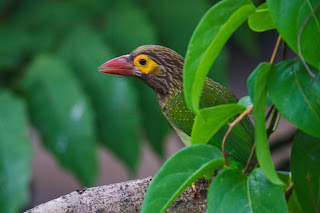A Brown Headed Barbet, also called the Large Green Barbet, photographed in Anuradhapura, Sri Lanka
A Brown Headed Barbet, also called Large Green Barbet, photographed in Colombo, Sri Lanka
The Barbet gets its name from the bristles which fringe their heavy beaks. The family of Asian Barbets comprises of 26 species and range from Indonesia to India and north to Tibet. They are usually plump looking birds with large heads and beaks and short tails and necks. None of the Asian Barbets are considered to be threatened. However, some of the species are known to be intolerant of deforestation and require old growth forests to thrive.
A Brown Headed Barbet, also called the Large Green Barbet, photographed in Colombo, Sri Lanka
A Brown Headed Barbet, also called Large Green Barbet, photographed in Colombo, Sri Lanka
Barbets build their nests by excavating a nesting burrow, usually high up on an exposed branch or tree trunk, out of reach of most predators. Normally a clutch comprises of 2 - 4 eggs which are incubated for 13 - 15 days.
A Brown Headed Barbet, also called the Large Green Barbet, photographed in Anuradhapura, Sri Lanka
A Brown Headed Barbet, also called Large Green Barbet, photographed in Colombo, Sri Lanka
Other images / info on Barbets


























